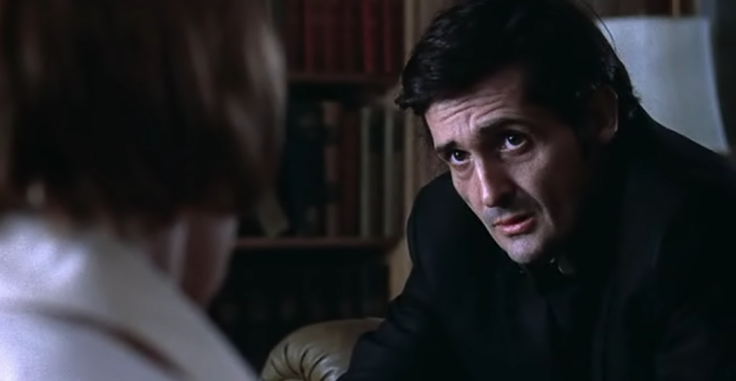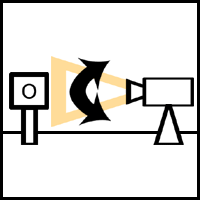Can you discuss the three production phases and set out broadly what happens at each stage?
There are various different shot sizes that we have covered such as:
- Close-ups (cu) are generally framed from the shoulders up. They are used to see what kind of emotion characters portray to get sympathy from the audience. Can you explain why the example below is a close-up?

- Extreme close-up (eu) focus on a part of the face, mostly common on the eyes or lips. Used to show intensity on a characters face to build tension. Can you explain why the example below is a close-up? I think the shot should be close for an ECU really it should really focus on one part of the face.

- Establishing shot (es) establishing shots are generally used at the beginning of a scene to introduce the audience to the setting. Can also be used to show contrast in the vastness of a setting relation to the character. Can you explain why the example below is an establishing shot?

- Over the shoulder shot (ots) features two characters, one character faces the camera and the other way. Other character faces away and only the back of their head and shoulders provide the frame.

- Medium shot (ms) lies between a medium long shot (knees upwards) medium closeup (chest upwards) this helps focus on body language and facial expression. Also helps to develop audiences understanding of the space between characters and objects. Can you explain why the example below is a MS?
- Medium long-shot.

- Medium closeup. Can you explain what this shot looks like and how it is used?

- Camera movement : Pan occurs when the camera pivots horizontally from a fixed position usually on a tripod but can be handed. Can be used to reveal important things in a scene; other characters, confines location or props, instead of a cut.

- Camera movement : Tilt is when the camera pivots vertically. Like a pan it is used to reveal something new in a scene instead of a cut. It helps from a viewers attention on key parts of a film.

- Point of view (pov) shots represent the subjective view of a character in the scene. Physically placed at the eye level of a character whose pov we are seeing can heighten the intimacy on the audience.

- Angles are subjects that are shot can affect the audiences understanding of their importance in a scene of who the character is. Shooting from a low angle gives the character a sense of power and importance, this can subtle as well as overtly low angle.

- Camera movement : Pan occurs when the camera pivots horizontally from a fixed position usually on a tripod but can be handed. Can be used to reveal important things in a scene; other characters, confines location or props, instead of a cut.
We have also learned about com-positional rules such as:
- The rule of thirds shot is split into thirds. Think about your images having this imaginary grid, your subject should be placed where the lines intersect. The idea is to place points of interest on or near the lines to create more dynamic images. Image also demonstrates using nose space or looking space for the subject to look into. Gives the audience a greater sense of the scene. Can you give some examples of this.
- Focal Point is where you decide on the most important or interesting part of the image. How can this be emphasised and why is it important to understand your focal point?
- Fill the Frame is filling the frame with your subject so it eliminates background ‘noise’ (avoid the middle.) Can you give an example?
- Dynamic Angles & view-points is using diagonals that gives a sense of drama-cow angles that will emphasise this. Low angles can also make the subject look dominant, where as high angle shots can make the subject look smaller and less imposing.
- Leading Lines help to draw the viewer into the scene. How and can you give an example?
- Colour & Shape are colours that complement each other that are pleasing on the eye and strong shapes will also add interest to your images.
- Space to move into give subjects space to look/move into in the image.
- Backgrounds should be uncluttered and not distinct the viewers attention from the scene.
- Depth of Field refers to the amount of the shot that is in focus.
It would be good to give an example for each of these.
We learned about how manual exposure is where you control the settings on the camera rather than the camera doing it automatically. For example:
- ISO is where you measure how sensitive the film stock digital sensor is to light. It is measured in doubled increments. Noise and loss of detail is another effect that altering the ISO has over your images. As your ISO rating increases so will the amount of noise in your image, which will result in lack of detail. Good description do you have any pictures that demonstrate this?
- Shutter speed is how quickly the cameras shutter opens and closes. Also consequently how long the film or sensor is exposed to light for. As well as exposure the shutter speed can affect motion blur in the scene. Can you give some examples of the effect shutter speed has? Shutter speed is expressed as a fraction. These fractions are measures of a second so a shutter speed of 1/60 would be one sixtieth of a second. On some modern DSLR cameras shutter speed can exceed one-thousandth of a second. And shutter speeds can exceed one second, the 550d’s that you use can be programmed to take an exposure of up to thirty seconds or for as long. What effect does shutter speed create? What is the rule of thumb when setting shutter speed for video?
- Aperture is the hole in the lens that light travels through. The larger the hole the more light is allowed to pass through. Affecting the amount of light affects the overall. These are effectively a sum that gives the dimension of the circle. The key thing to remember is the larger the f/ number the smaller the hole.As well as affecting exposure aperture also controls the depth of field. How does it affect depth of field? Why is this useful?
After learning about The Continuity Editing Rules I now understand how important they are and how you should follow them step by step. One of my favourite directors David Lynch once said “we think we understand the rules when we become adults but what we really experience is a narrowing of the imagination”.
- 180 rule is often called the line of action or simply crossing the line, the 180 rule states that once a camera is positioned on one side of the imagery line of action within a shot the camera cannot cut to a position across this line but must stay within the confines of the 180 arc. This then ensures a common space between shots.
- 30 rule is if the camera angle changes less than 30 degrees (with some framing) viewers may notice a visible jump cut. If the framing alters the 30 rule may not apply.
- Shot/Reverse Shot is often taken from opposing ends of the 180 line of action. First character is shown then we cut to the opposite end of the axis to reveal the second character.
- Re-establishing shot is after a series of edits a re-establishing shot is often inserted the re-affirm space.
- Eye-line Match is a shot of a character looking at something at the screen. A character looks at something/one off screen. We then cut to what is being looked at. This is not a POV shot. This is the most powerful combination of shots in cinema.
- Match on Action is a cut between two shots that combines the movement in the scene from one shot to another
- Elliptical Editing is where it cuts unnecessary action from a sequence. Shots next to each other should still make sense but from one shot to the next the audience can fill in the gaps.
- Jump cuts are a type of elliptical editing in that it removes unnecessary action from a scene. However jump cuts are a form of discontinuity editing because the camera angle does not change only the action changes.
- Graphic Match is a cut on a shape. A shape is on the next clip. Famously used in 2001- A Space Odyssey. They provide an artistic or stylish cut from one to another.
There are some very good and accurate descriptions of techniques throughout this post. You would improve it by including examples that demonstrate the technique or rule and further by explaining those examples. This will allow you to fully demonstrate an understanding of each of these techniques that you have learnt.
Leave a comment